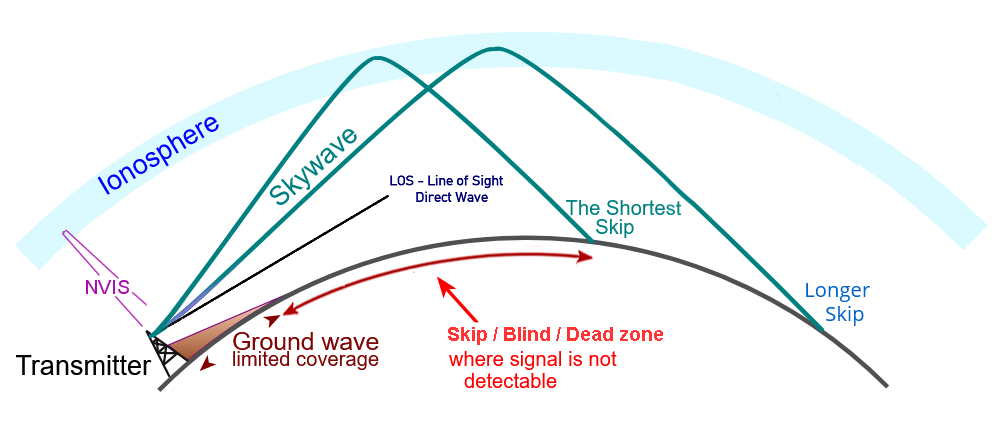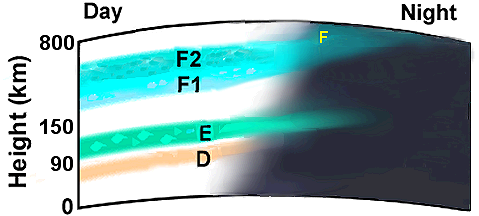
 HF Propagation Overview
HF Propagation Overview
High-frequency (HF) propagation refers to the way radio waves at frequencies between 3 and 30 MHz travel through the Earth's atmosphere. Understanding HF propagation is important for amateur radio operators, shortwave listeners, and professionals who rely on long-distance communication. This summary provides a concise overview of HF propagation over the horizon:
- Skywave propagation:
Radio waves above 2 MHz interact with Earth's upper atmosphere's charged ionosphere, refracting HF signals back to Earth and enabling long-distance communication through skywave propagation.

Figure 1: Skywave compared to other propagation modes2.1 The skip zone is the area between the point where the ground wave (directly transmitted signal) weakens and the skywave appears. Communication may prove difficult in this zone.
2.2 NVIS - Near Vertical Incidence Skywave (NVIS) is an effective solution for addressing skip zone issues. This propagation mode involves transmitting high-frequency signals at steep angles, which are then refracted back to Earth over short to medium distances. It is particularly well-suited for regional communication and demonstrates greater resilience to skip zones.
- Ionospheric regions (layers):
The ionosphere is divided into regions, each affecting radio propagation differently.

Figure 2: The ionospheric regionsFigure 2 illustrates ionospheric regions, labeled D, E, F1, and F2, with an additional label F on the night side. It highlights the variation in ionosphere regions between day and night, with the day side on the left and the night side on the right. This visual representation helps understand how the ionosphere's structure changes with the time of day.
The F2 region is the most important for long-distance HF communication as it refracts signals back to Earth. The lower regions (D and E) play a complex role, affecting propagation at various HF bands.
- Solar activity:
Solar activity, particularly sunspots, affects the ionosphere's electron density, influencing HF propagation conditions.
During periods of high solar activity, the ionosphere becomes more refractive, enhancing long-distance communication. Conversely, during solar minimum, the ionosphere may be less reflective, making communication more challenging.
- Day-night variation:
The ionosphere undergoes changes throughout the day due to solar radiation. During the day, the D and E regions are more pronounced, while the F region is more dominant at night. This day-night variation can impact the distance and reliability of HF communication.
- MUF (Maximum usable frequency) and LUF (Lowest usable frequency):
The MUF is the highest usable frequency for skywave propagation between two places at a given moment. Solar activity, time of day, and distance between transmitting and receiving stations all have an impact on this. It is not dependent on transmission power.
The LUF is the lowest frequency at which two radio stations can communicate at a given moment. It depends on ionospheric conditions caused by solar flares, solar wind, and geomagnetic activity, as well as path considerations. These variables all hinder mapping efforts. The LUF is mostly determined by the D region.
- Geomagnetic disturbances:
Geomagnetic storms, often caused by solar flares, can disrupt HF propagation by affecting the ionosphere. During such events, communication conditions may vary significantly!
- Frequency selection:
Different HF frequencies behave differently under various propagation conditions.
Lower frequencies (e.g., 3—7 MHz) are better for long-distance communication during periods of low solar activity and at night.
Higher frequencies (e.g., 14—30 MHz) may be suitable for shorter distances and daytime communication.
- Antenna considerations:
The type, orientation, height, and directionality of your antenna significantly influence propagation, with higher antennas increasing signal range and directional antennas focusing signals, while poorly placed ones can cause weak or distorted signals.
The efficiency of your antenna and its grounding also affect HF propagation. Good grounding and the right antenna can improve the effectiveness of your HF communication.
Experiment with different antenna types to find the one that works best for your specific situation.
- Geographical location and terrain:
The terrain and geography of your location significantly affect radio wave propagation, as obstacles like mountains or buildings can obstruct or reflect signals.
- Real-time propagation tools:
Various online tools and software can predict HF propagation conditions.
Summary: HF propagation is a complex dynamic process influenced by variables such as solar activity, geomagnetic data, frequency, time of day, and antenna properties. Experimenting with different bands, antenna configurations, and being informed about solar activity will help you enhance your understanding and maximize communication strategies for effective high-frequency communication. Link to the main page.
HF propagation status and alerts
Discover ham radio propagation
Real time radio propagation map
Current solar conditions Ham radio
Current Ham Radio HF Propagation
disrupted HF propagation conditions
HF Radio Propagation Search Terms
HF propagation for hams explained
Radio propagation for hams explained
Current HF Band Conditions Online Map
Skywave propagation for hams explained
Current Ham Radio Propagation Conditions
Real-time watching of worldwide ham activity
How does the sun affect radio communication?
Real-time watching of worldwide activity of hams
The Fascinating World of HF Skywave Propagation
Current HF Bands Conditions—Charts for Radio Hams
Discover the current solar and atmospheric conditions
Current HF Band Conditions Maps For Radio Operators
What is Radio Propagation Circuit?
The Path of Wireless Communication
What is Radio Communication Circuit?
Introduction to Wireless Communications
HF propagation Global Conditions Charts
HF propagation Regional Propagation Maps